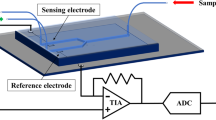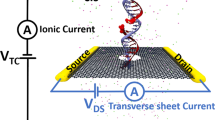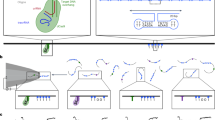Abstract
DNA charge transport chemistry is found to provide a sensitive method for probing protein-dependent changes in DNA structure and enzymatic reactions. Here we describe the development of an electrochemical assay of protein binding to DNA-modified electrodes based upon the detection of associated perturbations in DNA base stacking. Gold electrode surfaces that were modified with loosely packed DNA duplexes, covalently crosslinked to a redox-active intercalator and containing the binding site of the test protein, were constructed. Charge transport through DNA as a function of protein binding was then assayed. Substantial attenuation in current is seen in the presence of the base-flipping enzymes HhaI methylase and uracil DNA glycosylase, as well as with TATA-binding protein. When restriction endonuclease PvuII (R.PvuII) binds to its methylated target, little base-stacking perturbation occurs and little diminution in current flow is observed. Importantly, the kinetics of restriction by R.PvuII of its nonmethylated target is also easily monitored electrochemically. This approach should be generally applicable to assaying protein–DNA interactions and reactions on surfaces.
This is a preview of subscription content, access via your institution
Access options
Subscribe to this journal
Receive 12 print issues and online access
$209.00 per year
only $17.42 per issue
Buy this article
- Purchase on Springer Link
- Instant access to full article PDF
Prices may be subject to local taxes which are calculated during checkout



Similar content being viewed by others
References
Nunez, M.E. & Barton, J.K. Probing DNA charge transport with metallointercalators. Curr. Opin. Chem. Biol. 4, 199–206 (2000).
Kelley, S.O. & Barton, J.K. Electron transfer between bases in double helical DNA. Science 283, 375–381 (1999).
Schuster, G.B. Long-range charge transfer in DNA: transient structural distortions control the distance dependence. Acc. Chem. Res. 33, 253–260 (2000).
Kelley, S.O., Holmlin, R.E., Stemp, E.D.A. & Barton, J.K. Photoinduced electron transfer in ethidium-modified DNA duplexes—dependence on distance and base stacking. J. Am. Chem. Soc. 119, 9861–9870 (1997).
Boon, E.M., Ceres, D.M., Drummond, T.G., Hill, M.G. & Barton, J.K. Mutation detection by electrocatalysis at DNA-modified electrodes. Nature Biotech. 18, 1096–1100 (2000).
Kelley, S.O., Jackson, N.M., Hill, M.G. & Barton, J.K. Long-range electron transfer through DNA films. Angew. Chem. Int. Ed. Eng. 38, 941–945 (1998).
Kelley, S.O., Boon, E.M., Jackson, N.M., Hill, M.G. & Barton, J.K. Single-base mismatch detection based on charge transduction through DNA. Nucleic Acids Res. 27, 4830–4837 (1999).
Rajski, S.R. & Barton, J.K. How different DNA-binding proteins affect long-range oxidative damage to DNA. Biochemistry 40, 5556–5564 (2001).
Hall, D.B. & Barton, J.K. Sensitivity of DNA-mediated electron transfer to the intervening π-stack: a probe for the integrity of the DNA base stack. J. Am. Chem. Soc. 119, 5045–5046 (1997).
Rajski, S.R., Kumar, S.R., Roberts, R.J., & Barton, J.K. Protein-modulated DNA electron transfer. J. Am. Chem. Soc. 121, 5615–5616 (1999).
Wagenknecht, H.A., Rajski, S.R., Pascaly, M., Stemp, E.D.A. & Barton, J.K. Direct observation of radical intermediates in protein-dependent DNA charge transport. J. Am. Chem. Soc. 123, 4400–4407 (2001).
Hartwich, G. et al. Electrochemical study of electron transport through thin DNA films. J. Am. Chem. Soc. 121, 10803–10812 (1999).
Armistead, P.M. & Thorp, H.H. Modification of indium tin oxide electrodes with nucleic acids: detection of attomole quantities of immobilized DNA by electrocatalysis. Anal. Chem. 72, 3764–3770 (2000).
Patolsky, F., Lichtenstein, A. & Willner, I. Detection of single-base DNA mutations by enzyme-amplified electronic transduction. Nature Biotech. 19, 253–257 (2001).
Hashimoto, K., Ito, K. & Ishimori, Y. Sequence-specific gene detection with a gold electrode modified with DNA probes and an electrochemically active dye. Anal. Chem. 66, 3830–3833 (1994).
Kelley, S.O., Jackson, N.M., Barton, J.K. & Hill, M.G. Electrochemistry of methylene blue bound to a DNA-modified electrode. Bioconjug. Chem. 8, 31–37 (1997).
Herne, T.M. & Tarlov, M.J. Characterization of DNA probes immobilized on gold surfaces. J. Am. Chem. Soc. 119, 8916–8920 (1997).
Mui, S., Boon, E.M., Hill, M.G., Barton, J.K. & Spain, E.M. Morphology of 15-mer duplexes tethered to Au(111) probed using scanning probe microscopy. Langmuir 17, 5727–5730 (2001).
Kelley, S.O. et al. Orienting DNA helices on gold using applied electric fields. Langmuir 14, 6781–6784 (1998).
Bard, A.J. & Faulkner, L.R. Electrochemical methods (Wiley and Sons, New York; 1980).
Anson, F.C. & Osteryoung, R.A. Chronocoulometry—a convenient, rapid and reliable technique for detection and determination of adsorbed reactants. J. Chem. Ed. 60, 293–296 (1983).
Cheng, X., Kumar, S., Posfai, J., Pflugrath, J.W. & Roberts, R.J. Crystal-structure of the Hhal DNA methyltransferase complexed with S-adenosyl-L-methionine. Cell 74, 299–307 (1993).
O'Gara, M., Klimasauskas, S., Robers, R. J. & Cheng, X.D. Enzymatic C5-cytosine methylation of DNA: mechanistic implications of new crystal structures for HhaI methyltransferase–DNA–AdoHcy complexes. J. Mol. Biol. 261, 634–645 (1996).
Mi., S., Alonso, D. & Roberts, R.J. Functional-analysis of gln-237 mutants of Hhal methyltransferase. Nucleic Acids Res. 23, 620–627 (1995).
Garcia, R.A., Bustamante, C.J. & Reich, N.O. Sequence-specific recognition by cytosine C-5 and adenine N-6 DNA methyltransferases requires different deformations of DNA. Proc. Natl. Acad. Sci. USA 93, 7618–7622 (1996).
O'Gara, M., Horton, J.R., Roberts, R.J. & Cheng, X. Structures of HhaI methyltransferase complexed with substrates containing mismatches at the target base. Nature Sruct. Biol. 5, 872–877 (1998).
Slupphaug, G. et al. A nucleotide-flipping mechanism from the structure of human uracil–DNA glycosylase bound to DNA. Nature 384, 87–92 (1996).
Stivers, J.T., Pankiewicz, K.W. & Watanabe, K.A. Kinetic mechanism of damage site recognition and uracil flipping by Escherichia coli uracil DNA glycosylase. Biochemistry 38, 952–963 (1999).
Kim, J.L., Nikolov, D.B. & Burley, S.K. Co-crystal structure of TBP recognizing the minor-groove of a TATA element. Nature 365, 520–527 (1993).
Kim, Y., Geiger, J.H., Hahn, S. & Sigler, P.B. Crystal-structure of a yeast TBP TATA-box complex. Nature 365, 512–520 (1993).
Cheng, X., Balendiran, K., Schildkraut, I. & Anderson, J.E. Structure of PvuII endonuclease with cognate DNA. EMBO J. 13, 3927–3935 (1994).
Johnston, P.J. & Bryant, P.E. Lack of interference of DNA single-strand breaks with the measurement of double-strand breaks in mammalian-cells using the neutral filter elution assay. Nucleic Acids Res. 19, 2735–2738 (1991).
Arcamone, F. Doxorubicin: anticancer antibiotics (Academic Press, New York; 1981).
Acknowledgements
We are grateful to the NIH for their financial support (GM61077) and for an NRSA predoctoral fellowship (E.M.B.). We thank also the Caltech SURF program for a summer undergraduate fellowship (J.E.S.) and Donato Ceres for assistance in obtaining the scanning force microscopy images.
Author information
Authors and Affiliations
Corresponding author
Ethics declarations
Competing interests
Jacqueline K. Barton is a Founding Director of GeneOhm Sciences Inc. in San Diego, CA. GeneOhm Sciences has exclusive rights to license Caltech patents based upon this technology.
Rights and permissions
About this article
Cite this article
Boon, E., Salas, J. & Barton, J. An electrical probe of protein–DNA interactions on DNA-modified surfaces. Nat Biotechnol 20, 282–286 (2002). https://doi.org/10.1038/nbt0302-282
Received:
Accepted:
Issue Date:
DOI: https://doi.org/10.1038/nbt0302-282
This article is cited by
-
A human MUTYH variant linking colonic polyposis to redox degradation of the [4Fe4S]2+ cluster
Nature Chemistry (2018)
-
Hole Transport in A-form DNA/RNA Hybrid Duplexes
Scientific Reports (2017)
-
Biophysical and electrochemical studies of protein–nucleic acid interactions
Monatshefte für Chemie - Chemical Monthly (2015)
-
AFM-assisted fabrication of thiol SAM pattern with alternating quantified surface potential
Nanoscale Research Letters (2011)
-
The self-organizing fractal theory as a universal discovery method: the phenomenon of life
Theoretical Biology and Medical Modelling (2011)



